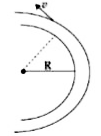A car of mass m is moving on a level circular track of radius R if μs represents the static friction between the road and tyres of the car, the maximum speed of the car in circular motion is given by.
√μsmRg
√Rgμs
√mRgμs
√μsRg
Step by step video & image solution for A car of mass m is moving on a level circular track of radius R if mu_(s) represents the static friction between the road and tyres of the car, the maximum speed of the car in circular motion is given by. by Physics experts to help you in doubts & scoring excellent marks in Class 12 exams.
Updated on:21/07/2023Topper's Solved these Questions
- LAWS OF MOTIONBOOK - AAKASH INSTITUTECHAPTER - LAWS OF MOTIONEXERCISE - Assignment (SECTION-D) (Assertion-Reason Type Questions)
15 Videos
- LAWS OF MOTIONBOOK - AAKASH INSTITUTECHAPTER - LAWS OF MOTIONEXERCISE - Assignment (SECTION-B)
44 Videos
- KINETIC THEORYBOOK - AAKASH INSTITUTECHAPTER - KINETIC THEORYEXERCISE - EXERCISE (ASSIGNMENT) SECTION - D Assertion - Reason Type Questions
10 Videos
- MAGNETISM AND MATTER BOOK - AAKASH INSTITUTECHAPTER - MAGNETISM AND MATTER EXERCISE - ASSIGNMENT (SECTION D)
26 Videos
Similar Questions
A car has to move on a level turn of radius 45 m. If the coefficient of static friction between the tire and the road is μs=2.0, find the maximum speed the car can take without skidding.
View SolutionA car of maas M is moving on a horizontal circular path of radius r. At an instant its speed is v and is increasing at a rate a.
View Solution
Knowledge Check
A 100kg car is moving with a maximum velocity of 9m/s across a circular track of radius 30 m . The maximum force of friction between the road and the car is
A1000NB706NC270ND200NA car is taking turn on a circular path of radius R. If the coefficient of friction between the tyres and road is μ, the maximum velocity for no slipping is
AμRgB2μRgC(μRg)1/2D(2μRg)1/2A car of mass 1000 kg moves on a circular track of radius 20 m . If the coefficient of friction is 0.64, then the maximum velocity with which the car can move is
A22.4 m/sB5.6 m/sC11.2 m/sD6.5 m/s
A modern gran -prix racing car of masses m is travelling on a flat track in a circular arc of radius R with a speed v. If the coefficient of static friction between the tyres and the track is μs, then the magnitude of negative lift FL acting downwards on the car is : ( Assume forces on the four tyres are identical and g = acceleration due to gravity )

View SolutionA car is moving on a horizontal circular track of radius 0.2 km with a constant speed. If coefficient of friction between tyres of car and road is 0.45, then maximum speed of car may be [Take g=10m/s2]
View SolutionFind the maximum velocity for skidding for a car moved on a circular track of radius 100 m . The coefficient of friction between the road and tyre is 0.2
View SolutionA car of mass 800 kg moves on a circular track of radius 40 m . If the coefficient of friction is 0.5, then maximum velocity with which the car can move is
View SolutionA car of mass 1000 kg moves on a circular track of radius 20 . If the coefficient of friction is 0.64, then the maximum velocity with which the car can move is
View Solution
